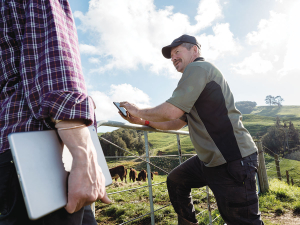2024/25 Dairy Statistics: NZ dairy farmers boost production with fewer cows
According to the New Zealand Dairy Statistics 2024/25 report, New Zealand dairy farmers are achieving more with fewer cows.
 The data, collected from LIC’s MINDA software, showed that at 22 months, heifers on average are around 4-5% below MINDA guidelines.
The data, collected from LIC’s MINDA software, showed that at 22 months, heifers on average are around 4-5% below MINDA guidelines.
Dairy farmers can easily track the performance of their replacement heifers and ensure they reach their genetic potential.
Weighing technology can help farmers to meet crucial heifer liveweights at first mating and calving boosting in-calf rates and increasing milk production, says Gallagher head of animal performance and traceability Brian Rose.
New data from LIC shows that too many farmers are not weighing their heifers when they return from grazing – and are missing out on big genetic gains as a result. LIC believes the impact on farms is huge, leading to poor heifer fertility and production. It means farmers are not maximising their return on investment from breeding the heifer and are risking her first-year production potential.
Rose says while the statistics are not ideal, there is simple technology available that can help. He says electronic identification (EID) and weighing solutions are now able to give farmers accurate information on whether their heifers are meeting the targets.
Each animal’s EID number is scanned using a portable hand-held tag reader or hands-free reader in the yards, which are connected to a compatible weigh scale to collect weights and other livestock records.
The target heifer weights and dates can be imported from MINDA, which means the farmer can see in real time if each individual heifer is on track to meet her targets. If not, it presents an opportunity to adjust management practices accordingly.
|
A landmark moment for New Zealand. That's how Prime Minister Christopher Luxon describes the conclusion of negotiations for an India-New Zealand Free Trade Agreement. Beef Progeny Test 2025: Genetic insights for NZ beef industryAt Pāmu’s Kepler Farm in Manapouri, mating has wrapped up at the across-breed Beef Progeny Test. HortNZ celebrates 20 YearsMore than 150 people turned up at Parliament recently to celebrate the 20th anniversary of Horticulture New Zealand (HortNZ). Biosecurity NZ urges vigilance for yellow-legged hornetsBiosecurity New Zealand says Kiwis should continue to keep an eye out for yellow-legged hornets (Vespa velutina) over the holiday season. Mental Health and Fitness Unite: The Push-Up Challenge comes to New ZealandThe Push-Up Challenge, an event which combines mental health and fitness, is set to launch in New Zealand in 2026. Agritechnica 2025: Claas, Fendt and Valtra claim 2026 Tractor of the Year AwardsLast month's Agritechnica event led to a wide group of manufacturers celebrating successes when the 2026 Tractor of the Year Competition winners, selected by a panel of European journalists, were announced in Hanover Germany. NationalAlliance commissions major heat pump system at Mataura, cutting coal use and emissionsAlliance Group has commissioned a new heat pump system at its Mataura processing plant in Southland.NZ meat industry seeks removal of US 15% lamb tariffMeat processors are hopeful that the additional 15% tariff on lamb exports to the US will also come off.Early drought fears ease in Hawke’s Bay, but caution remainsFears of a serious early drought in Hawke’s Bay have been allayed – for the moment at least.Consent Rollovers and $13b Savings: What the new RMA bills could meanThere was much theatre in the Beehive before the Government's new Resource Management Act (RMA) reform bills were introduced into…Rural bias?OPINION: After years of ever-worsening results from our education system, the startling results from a maths acceleration programme stood out like…Machinery & ProductsAgriSpread AS3000 Bulk Spreader: Precision spreading up to 52mManufactured in Ireland, tested and launched at Agritechnica in Germany, AgriSpread’s new AS3000 bulk spreader takes much of the technology…Agritechnica 2025: Claas, Fendt and Valtra claim 2026 Tractor of the Year AwardsLast month's Agritechnica event led to a wide group of manufacturers celebrating successes when the 2026 Tractor of the Year…New Case IH Puma series debuts with improved design & precision techCase IH used Agritechnica to reveal its new Puma series tractor, featuring what it claims is an entirely new vehicle…New Holland unveils “Il Trattore” concept at AgritechnicaCreating a great deal of enthusiasm at Agritechnica, the T5.120 ‘Il Trattore’ styling concept tractor was celebrating the legacy of…Deutz-Fahr unveils all-new 8 series tractor range at AgritechnicaAgritechnica was the launchpad for several “new” tractors, most reworks of existing models, but Deutz Fahr ‘s new 8 Series was…» Latest Print Issues OnlineThe Hound
Yes, Minister!OPINION: The release of the Natural Environment Bill and Planning Bill to replace the Resource Management Act is a red-letter day… Two-legged pestsOPINION: Federated Farmers has launched a new campaign, swapping ‘The Twelve Days of Christmas’ for ‘The Twelve Pests of Christmas’ to… » Connect with Rural News» eNewsletter |